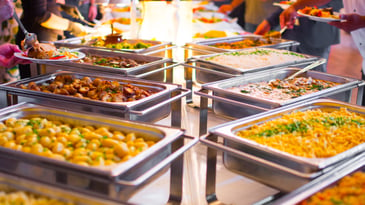 Ask any catering professional what they love about their job, and many will say the flexibility. In the morning you’re serving an elegant brunch for 30, and in the evening you’re dishing out barbecue to 200 guests at a country-style wedding. You have the freedom to create new dishes, collaborate on custom menus, and think up new ways to surprise and delight your customers.
Ask any catering professional what they love about their job, and many will say the flexibility. In the morning you’re serving an elegant brunch for 30, and in the evening you’re dishing out barbecue to 200 guests at a country-style wedding. You have the freedom to create new dishes, collaborate on custom menus, and think up new ways to surprise and delight your customers.
There’s a downside to flexibility, however. Caterers constantly have to adapt to rising food costs, changing headcounts, and shifting menu trends. Here are some of the top challenges caterers face, plus a few ways having the right kitchen equipment can help.
Challenge #1: Cutting food costs
This may be the number-one challenge faced by catering companies — a challenge that only gets tougher with volatile global food prices. To reduce food costs, it’s worth investing some time in comparison-shopping. Identify the ingredients you a) use most often and b) spend the most on. Check to see if your supplier is giving you the best deal. If one of your signature dishes uses grass-fed beef, for instance, you may find a local butcher or farm that will give you a better product for a lower price than the big distributors.
You can save on food costs by buying large quantities of frequently used ingredients, such as chicken breasts or salmon. Portion out these proteins, season or marinate if desired, then vacuum-seal them to maintain quality and prevent freezer burn.
The PrimaVac™ line of vacuum packaging machines makes it easy! Unlike suction vacuum sealers, which can only seal dry ingredients, our chamber vacuum packaging machine can handle liquids, marinades and more.
Challenge #2: Reducing food waste
Between 4% and 10% of food purchased is thrown out before it reaches a diner’s plate, according to more than a decade of LeanPath research. That waste is a heavy drag on your catering business’s bottom line… but you have the power to reduce it.
First, appoint a team member to be the food-delivery point person. Their job is to process and put away incoming deliveries the moment they arrive, no matter how busy the kitchen may be. If you wash iceberg lettuce as soon as it comes in and vacuum-seal it, “you’ve automatically gotten an extra three weeks out of a product,” says Sandra D. Ratcliff, CEC, Managing Partner at The Fischer Group. Do the same for other ingredients, such as fresh fish, meat, and cheeses.
Some of our customers report that their PrimaVac™ sealer paid for itself in just 5 to 7 weeks, because they’re able to reduce their food spoilage/waste costs by $200-$300 each week.
Just be sure to take the time to thoroughly train your staff in food-safety practices for reduced oxygen packaging (ROP). Vacuum sealing extends the shelf life of food by removing oxygen, which preserves color, texture and flavor longer. However, certain bacteria (such as botulinum) can thrive in anaerobic environments, and so care must be taken with vacuum-sealed perishables. Remove frozen fish from its sealed packaging before thawing, and avoid vacuum-sealing raw onions, fresh mushrooms or fresh garlic.
What about plate waste? For caterers, the buffet is the biggest food-waste challenge. To wow customers, the food on display must appear abundant. But the more food you provide, the more likely it is that diners will over-serve themselves.
LeanPath suggests some subtle but effective ways to reduce waste in self-service settings. Encourage customers to take less food by providing smaller serving utensils and plates with wider rims. Pre-portion items in individual dishes. As buffet demand begins to decrease, replenish the table with smaller pans of food.
Challenge #3: Maximizing kitchen space
Has there ever been a catering kitchen that was big enough? Whether you cater small gatherings or massive events, there always seems to come a moment when you run out of room.
The best catering equipment is both compact and multi-functional, to help make the most of the space you have. For example:
- The BigRig™ family of commercial immersion blenders is both powerful and ultra-portable to handle high-volume blending: soups, sauces, salsas, etc. The detachable shaft is dishwasher-safe, and immersion blenders can be stored on a hook or a rack when they’re not being used.
- The 8 quart/7.6 liter CPM800 stand mixer is both powerful and compact to save counter space. Plus, it can do much more than knead dough and mix batters: try shredding cooked meats, making guacamole and more.
- A commercial rice cooker makes more than rice. Use it for applesauce and stewed fruits, macaroni and cheese, chili, polenta, quinoa and more. A huge benefit for catering operations is the ability to hold food at a safe temperature and keep dishes hot without boiling over for up to 4 hours. Save even more time by batch-cooking rice and keeping it at food safe temperature with a rice warmer. The inner pot can be moved right from the cooker to the warmer for extra efficiency.
Get more tips for optimizing space in a restaurant kitchen
Whether you’re launching or growing your catering business, Hamilton Beach Commercial is there to support you. Our commercial kitchen equipment is compact, cost-effective, and built with the legendary durability we’re known for.
Shop our full line of commercial foodservice equipment solutions.



